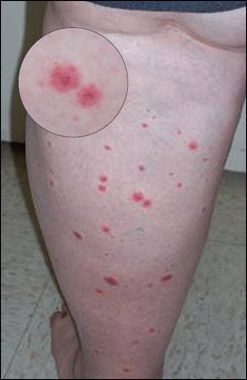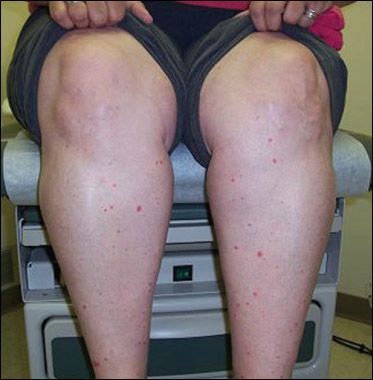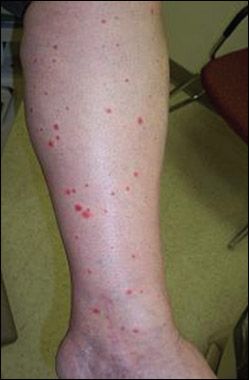Can You Identify This Puzzling Rash?
Apreviously healthy 47-year-old woman presents with an ascending, nonpruritic rash of 3 days’ duration on her legs. She reports that the rash began on her ankles following a day of gardening. She does not recall any recent insect bites and denies chest pain, dyspnea, abdominal pain, fever, arthralgia, arthritis, cough, and hemoptysis. She has never had a similar rash before. The patient’s only medication is an oral antihistamine for seasonal allergies. She has no known drug allergies.

A previously healthy 47-year-old woman presents with an ascending, nonpruritic rash of 3 days' duration on her legs. She reports that the rash began on her ankles following a day of gardening. She does not recall any recent insect bites and denies chest pain, dyspnea, abdominal pain, fever, arthralgia, arthritis, cough, and hemoptysis. She has never had a similar rash before. The patient's only medication is an oral antihistamine for seasonal allergies. She has no known drug allergies.
The diffuse, uniformly distributed maculopapular rash involves the lower extremities bilaterally from the ankles to the knees. The lesions are red and nonblanching, with a central darkened area, and range from 1 to 5 mm in diameter. No lymphadenopathy is noted. Results of chest, cardiac, and abdominal examinations are unremarkable. Laboratory studies reveal an elevated erythrocyte sedimentation rate (34 mm/h) and C-reactive protein level (2.0 mg/dL). Complete blood cell count with differential, comprehensive metabolic panel, prothrombin time, partial thromboplastin time, and international normalized ratio are all within normal limits.
Answer: Acute leukocytoclastic vasculitis

Figure 1 – This bilateral ascending maculopapular rash involves the flexor and extensor surfaces of the lower extremities.
Histopathological examination of the biopsy specimen revealed vascular and perivascular polymorphonuclear leukocyte infiltration with formation of nuclear dust, erythrocyte extravasation, and fibrinoid necrosis of the postcapillary venule walls. Based on the clinical picture and histopathology, acute leukocytoclastic vasculitis was diagnosed. The patient was treated with an oral prednisone taper (1 mg/kg/d) over 4 weeks with significant clearing of the rash at 5-week follow-up.
LEUKOCYTOCLASTIC VASCULITIS: AN OVERVIEW
Leukocytoclastic vasculitis-also known as hypersensitivity vasculitis, cutaneous leukocytoclastic angiitis, and cutaneous small-vessel vasculitis-is a small-vessel vasculitis limited to the skin that is not associated with other primary or secondary vasculitides. The reported incidence is 10 to 30 cases per million persons per year and is equal in both sexes; it can occur at any age. Often a precipitant such as a medication (eg, antibiotics, NSAIDs),1 upper respiratory tract infection, hepatitis C, HIV infection, collagen vascular disease, malignancy,2 or inflammatory bowel disease is identified; however, no source is found in 40% to 60% of cases. Inflammatory vascular damage results from immune complex formation and deposition in the walls of small blood vessels with subsequent complement activation and neutrophil entry, followed by release of oxidative enzymes leading to cellular destruction.3
CLINICAL FINDINGS
Typically, a nonblanching, palpable or nonpalpable purpura occurs in crops of similar age on dependent areas, such as the legs and buttocks (Figures 1 and 2).4 Although less common, cutaneous lesions, including papules, urticaria, erythema multiforme, vesicles, pustules, ulcers, or frank necrosis, may also occur. Occasional large-joint involvement presents as arthralgia or even arthritis.

Figure 2 – Maculopapular lesions of variable size with areas of central darkening represent cutaneous vasculitis with central necrosis.
DIAGNOSTIC CRITERIA
Diagnosis requires at least 3 of the following criteria:
DIFFERENTIAL DIAGNOSIS
The diagnosis of hypersensitivity vasculitis requires that infections, hematological abnormalities such as thrombotic thrombocytopenic purpura and idiopathic thrombocytopenic purpura, autoimmune diseases with cutaneous and joint involvement, and other forms of smallvessel vasculitis be ruled out.
Furthermore, be aware that skin findings may indicate more sinister underlying organ involvement. Forms of primary vasculitis, such as Henoch-Schnlein purpura, microscopic polyangiitis, and Wegener granulomatosis, and secondary vasculitis, such as mixed cryoglobulinemia, must be considered.
PATHOLOGY
Biopsy of cutaneous lesions typically demonstrates leukocytoclastic vasculitis (fibrinoid necrosis) involving the postcapillary venules of the superficial plexus of the dermis.5 Immunofluorescence characteristically reveals immunoglobulin and complement deposition in a nondiagnostic pattern. Histopathology is important in the exclusion of Henoch-Schnlein purpura and cryoglobulinemia as alternative diagnoses.
Poll Results
Online Poll
Powered By
WebsiteGear
: Requires Javascript Enabled On Your Browser.
MANAGEMENT
Treatment of leukocytoclastic vasculitis is focused on identification and removal of the precipitating source. Most cases of mild to moderate hypersensitivity vasculitis resolve spontaneously in a few days to weeks with removal of the offending precipitant.
For more severe or refractory cases of skin involvement- with or without joint manifestations-NSAIDs, colchicine,6,7 or dapsone may be effective. Patients with urticarial lesions may be treated with antihistamines, while those with severe visceral involvement usually require high doses of oral corticosteroids (1 to 2 mg/kg/d) or immunosuppressive agents such as methotrexate, azathioprine, or cyclosporine. Rituximab, an antibody directed against CD20, has reportedly been successful in various subsets of patients with vasculitis, including several patients with chronic cutaneous small-vessel vasculitis.8 With treatment, most cases of leukocytoclastic vasculitis resolve in 1 to 4 weeks, but skin hyperpigmentation may persist at the site of the lesions.
References:
REFERENCES:1. Jordan KM, Edwards CJ, Arden NK. Allergic vasculitis associated with celecoxib. Rheumatology (Oxford). 2002;41:1453-1455.
2. Lacour JP, Castanet J, Perrin C, et al. Cutaneous leukocytoclastic vasculitis and renal cancer: two cases. Am J Med. 1993;94:104-108.
3. Stone JH. Hypersensitivity vasculitis. In: Imboden J, Hellmann D, Stone J, eds. Current Diagnosis & Treatment in Rheumatology. 2nd ed. New York: McGraw-Hill; 2007:308-311.
4. Requena L, Sánchez Yus E, Kutzner H. Panniculitis. In: Wolff K, Goldsmith LA, Katz SI, et al, eds. Fitzpatrick's Dermatology in General Medicine. 7th ed. 2 vols. New York: McGraw-Hill; 2008.
5. McCalmont TH. Diseases of the skin. In: McPhee SJ, Ganong WF, eds. Pathophysiology of Disease: An Introduction to Clinical Medicine. 5th ed. New York: McGraw-Hill; 2006.
6. Callen JP. Colchicine is effective in controlling chronic cutaneous leukocytoclastic vasculitis. J Am Acad Dermatol. 1985;13(2, pt 1):193-200.
7. Sais G, Vidaller A, Jucglà A, et al. Colchicine in the treatment of cutaneous leukocytoclastic vasculitis. Results of a prospective, randomized controlled trial. Arch Dermatol. 1995;131:1399-1402.
8. Keogh KA, Ytterberg SR, Fervenza FC, et al. Rituximab for refractory Wegener's granulomatosis: report of a prospective, open label pilot trial. Am J Respir Crit Care Med. 2006;173:180-187.